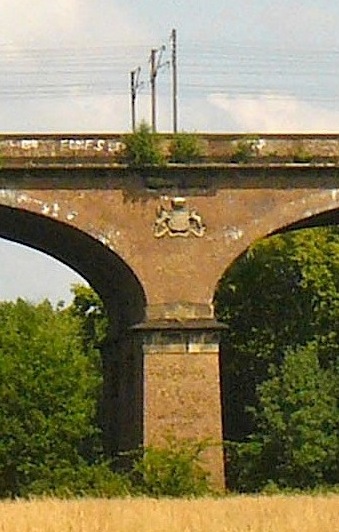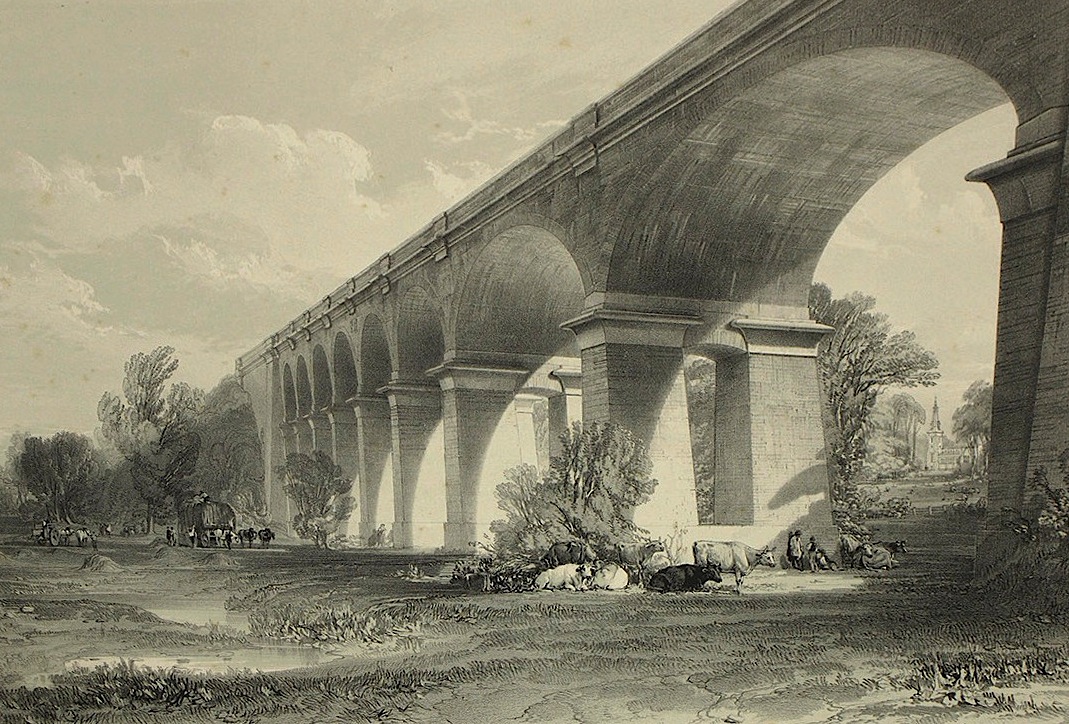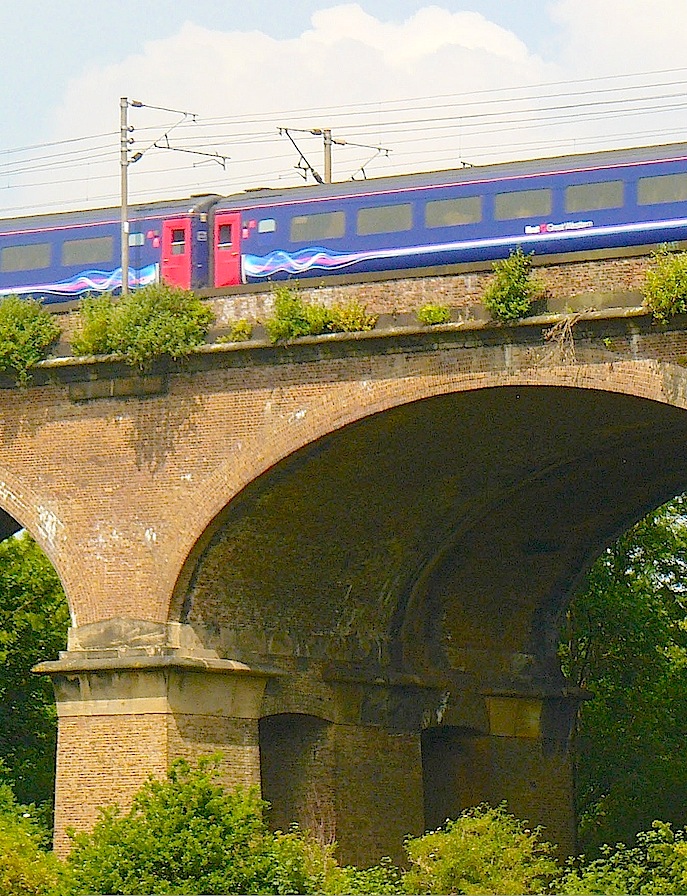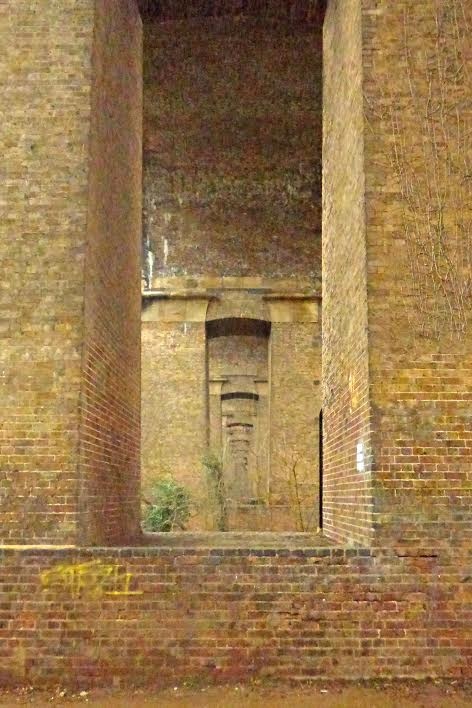
The Wharncliffe Viaduct from Southall to Hanwell in the London Borough of Ealing, for the Great Western Railway, built 1836-37 ‐ the first of their viaducts to be completed. It is amazing to see this in Greater London, but, as Bridget Cherry and Nikolaus Pevsner say, the borough of Ealing is "pleasingly varied" (149), and this is the old valley of the River Brent. [Click on this and the following images for larger pictures.]
The engineer of this fine Grade I listed structure was Isambard Kingdom Brunel, and the contractors were Grissell and Peto. According to Grace's Guide, it was Brunel's first major work. Built of brown brick with stone imposts and detailing, the viaduct is 886 feet long, each of its eight arches being 70 feet in span and reaching a height of 19 feet (see listing text; other sources give slightly different figures, e.g. G. A. Sekon, writing in the nineteenth century, gives the overall length as 896 feet, and the height of the arches as 18 feet, see p. 12). More figures from the listing text: the height to the parapet is 81 feet; the original width of 30 feet was later increased on the north side, almost doubling it in this respect. This was necessitated by the 1846 Gauge Act making Stephenson's narrow gauge the standard across the country. The new width was/is 55 feet. At this time the pylon-type piers, originally in sets of twos (as shown in the black-and-white scan below right), were increased to sets of three. The present arrangement can be seen by looking inside the arches in the image on the right below, which also shows a train running over the viaduct.



Left to right: (a) Central part of the viaduct, showing the Wharncliffe arms. (b) The narrower viaduct as it was in 1846. Source: Bourne. (c) The viaduct in use now, with a train crossing it. The three flared supporting piers of the arches are seen clearly here.
On the centre of the south face of this wonderful piece of living industrial history, as seen above left, are the arms of James Stuart Wortley Mackenzie, Lord Wharncliffe, Chairman of the Committee in the House of Lords responsible for the passing of the Great Western Railway Bill [close-up of the arms here]. The telegraph wires are not later additions, as might be supposed:
Brunel was quick to see the possible advantages of the early electric telegraph system for use in running the railway. In 1838 he persuaded Charles Wheatstone and William Fothergill Cooke to install their five-needle telegraph system between Paddington Station and West Drayton and to carry out experiments. It proved to be useful, so the viaduct thus carried the world's first commercial electrical telegraph, on 9 April 1839. ["Wharncliffe Viaduct," Grace's Guide]
Of the viaduct in general, the early railway historian Sekon writes:
here we have one of the many remarkable engineering achievements for which this line is famous.... The Great Western Railway was at the time of its construction truly described as "the most gigantic work, not only in Great Britain, not only in Europe, but in the entire world," and taking the Great Western Railway system in its completeness as it exists to-day, the words still remain true despite the very many stupendous engineering triumphs that have since been gained in other parts of the Universe. Nor did Brunel himself underrate the importance of the work he was engaged in, for on the 26th December 1835 he wrote in his diary this short but expressive sentence: "I am engineer to the finest work in England." [12]
Sekon continues by describing the viaduct as "a remarkable instance of successful architectural invention, and, as a piece of masonry,

perfect ... everywhere accurately formed, well put together, dry, and in good condition.... No one should leave this bridge without going under one of the extreme arches and looking along through the openings in the piers to the other extremity, where he will see a cyclopean colonnade stretching far away in distant perspective, and carry away with him a memorable and not unpleasing impression. [13-14]
(Note the typically British understatement, "not unpleasing"!) The "cyclopean colonnade" can be seen on the right here. Incidentally, Cherry and Pevsner describe the piers as "Egyptian style" — which would have been fashionable at the time. These architectural historians add their own praise, saying, "Few viaducts have such architectural panache" (185).
Photographs by Colin Price, and commentary and formatting by Jacqueline Banerjee. [You may use these images without prior permission for any scholarly or educational purpose as long as you (1) credit the photographer and (2) link your document to this URL in a web document or to the Victorian Web in a print document.]
Examples of other viaducts
- Dent Head Viaduct (Midland Railway, 1870-75)
- Arten Gill Viaduct under construction (Midland Railway, 1871-75)
Sources
Bourne, J. C. History and Description of the Great Western Railway. London: David Bogue, 1846. Open Research Exeter (University of Exeter). Web. 5 March 2016.
Cherry, Bridget, and Nikolaus Pevsner. London 3: North West. New Haven and London: Yale University Press, 2002.
Sekon, G. A. A History of the Great Western Railway; being the story of the broad gauge. London: Digby, Long, 1895. Internet Archive. Contributed by Robarts Library, University of Toronto. Web. 5 March 2016.
"Wharncliffe Viaduct." engineeringtimelines. Web. 5 March 2016.
"Warncliffe Viaduct." Historic England. Web. 5 March 2016.
"Wharncliffe Viaduct." Grace's Guide to British Industrial History. Web. 5 March 2016.
Created 5 March 2016